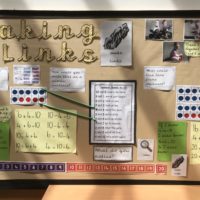It’s wonderful to be carried away by inspirational platform speakers who take you into the realms of possibility, speak to your inner beliefs about learning, and make change sound oh-so easy. And yet we know that anything worthwhile is never a matter of tweaks here and there, but more a stretching, sometimes tricky, learning journey for everyone in the school. This week we are offered a rare insight into such a learning journey. Shelagh Hughes, headteacher of the Keswick school we have followed over the last couple of weeks, talks about why she was attracted to the idea of Learning Power, how it developed in the school and how the children now behave as learners. It’s grounded in reality and all the more inspirational for that. Have a listen, take a look.
Why BLP: starting the journey
Shelagh begins with a wonder…how is it that children seem to learn more naturally and with greater motivation from outdoor learning? How might we make that happen indoors in classrooms? The framework of Learning Power behaviours seemed to offer a way to bring important learning behaviours into the classroom.
Getting it going in the school started out with a small group of champions, but quickly became a learning journey for all staff. They met, talked, explored, tried things out, watched each other teach, monitored what seemed to work and what didn’t, asked themselves what and how children’s learning behaviours had changed. The school had become what is often referred to as a ‘learning community’, spurred on by noticing the joy and relish children had for learning.
The effect of learning power on children’s learning
Here Shelagh talks about how the children have changed as learners. They moved from being passive, defensive, timid learners into active, enthusiastic and self regulated learners. She didn’t use the high-falutin’ language of meta-cognition but that’s what she is describing. Learners in this school are becoming skilled meta-cognitive learners and as Shelagh says ‘they now see learning in a completely different way’.
Learning Power drives the curriculum
This next snippet of video is probably the most illuminating insight into Learning Power that will help any school take it forward to a deeper, more satisfying, level. Watch it, question it, watch it again, think about it and learn from it.
Where is your school now? Pre-‘bolt on’ stage where you are introducing learning behaviours? At the bolt on stage? At the split screen stage? Or at the ‘start with the learning before subject content’ stage?
We have talked a lot in the past about teachers becoming more forensic about learning and Shelagh’s description captures what this means. Teachers know that by using the learning behaviours consciously, in order to learn, the children will develop their power to learn throughout life. So now the behaviours, the how of learning, come first when planning learning. Teachers ask how the behaviour can s t r e t c h learning the content. ‘How can I use..?’, devising generative questions, or listening for specific facts, or catapulting their imagination into the lives of others, to help students better understand, extend, and remember this content. The Yr 6 maths lesson we saw a couple of weeks ago illustrated this way of thinking about learning.
Progression and the breakthrough in understanding
Here Shelagh offers more insights into how the learning behaviours have been ‘dripped’ into the school and gradually unpicked. What do they really mean? How do they grow? How can our teaching encourage and enable that growth?
So teachers don’t simply use the name of the behaviour…’we are using our Reasoning today’… but they have thought underneath the word about what reasoning means. What’s the language of reasoning? What do we do when we reason? Are some reasoning actions harder and more sophisticated than others? Here’s a hotch-potch of examples:
- evaluates pros and cons
- “Is that the right answer? Because..? I reckon…”
- proves
- seeks evidence to support their thinking
- justifies
- convinces
- speculates, conjectures
- spots patterns
- visualises
- works backwards
- shows how they worked something out
- explains why they think….
All this and more is the language of reasoning. Such picking apart has helped teachers to better understand the behaviour, use it more accurately to stretch it, and apply that stretch to content understanding.
The realisation of the centrality of the learning behaviour came from looking at their classroom displays. They often put the learning behaviour in the middle of a display board and arranged pictures and words and samples of learning round about. Those displays were unknowingly arranged as a mindmap of what had been happening and lead to the realisation that teachers could flip their thinking from content first to learning behaviour first.
Listen to Shelagh’s explanation, take a look at a typical display and listen to infant teacher Helen, a key advocate of the approach, putting their explanation into a nutshell.
So as you can see, using learning power in the classroom isn’t about the simplistic use of the names of learning behaviours…imagining, listening, noticing, planning etc. It’s about digging underneath those words for their meaning and the components that make them up; extending the language of learning by understanding the behaviours; stretching the understanding of content by designing learning opportunities where students can use and apply those behaviours to learning. It needn’t take five years, because we have all learned more about how to do it now, and we have lots of resources to help you along the journey.


No comments yet.